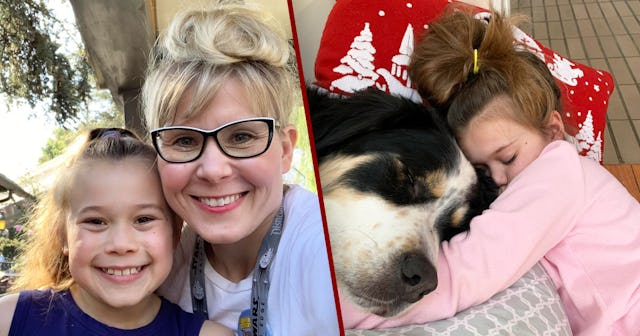Mom Shares Harrowing Story Of How Long Haul COVID Has Affected Her Child

I “met” Jody Burt and her daughter Anna on a warm, August day. Our conversation was virtual. She was at home in South Dakota. I was locked in my bedroom, hiding from my very adorable but noisy kids. Our meeting was cordial. She greeted me in the most humble and lovely of ways, and our call — which was nearly an hour long — was the culmination of more than a dozen emails. But such is life when you have scheduling conflicts and children. Well, such is life when you have scheduling conflicts and sick children, which both Jody and I had. My son fell ill the week prior to our (first) scheduled conversation. Her daughter fell ill in October. But the irony is, that’s what our call was about: illness. Because Jody’s daughter Anna is one of millions living with long haul COVID.
She is just 11 years old.
Courtesy of Jody Burt
Jody’s (and Anna’s) story starts like many others. Her daughter contracted the illness after an exposure at school. Eight children were quarantined. Several experienced symptoms. But Jody was told her daughter did not have COVID. Her test came back negative. Doctors suggested constipation was the cause of her fever and abdominal distress.
But after two months of fatigue, nausea, headaches, and pain, Jody demanded answers. She asked her for a full panel workup, and what the doctors found surprised them. Anna had COVID antibodies, meaning that — at some point — she had contracted the disease.
Courtesy of Jody Burt
“For months, it felt like nobody was believing us,” Jody told me. “They were concerned about her appendix, but they ruled appendicitis out. People kept on saying it was constipation, but you don’t have a fever with constipation. I knew that wasn’t right. But nobody was checking for COVID. We didn’t get a positive result. For two months, we went without answers — and that was frustrating, for Anna and I. It was scary.”
Courtesy of Jody Burt
The good news is that, with the test results in hand, Jody and Anna could move forward. “After getting the antibody results, we were finally able to get the ball rolling,” Jody explained. “Anna saw several doctors, including a rheumatologist — who was the first one who suggested this could be long-haul COVID.”
“In February, I called Omaha Children’s Hospital and the University of Minnesota Children’s Hospital because both had long-haul COVID centers. I told them about Anna and asked if either would be willing to see her. Omaha wasn’t an option, but Minnesota got us in the following week, and we saw their infectious disease doctor days later. He listened and cared. He started the visit by saying ‘Anna, the first thing I want to tell you is we believe you.’ And that? That meant so much to her. Some of those visits with some of the specialists we had left her in tears. She felt like ‘Mom they didn’t believe me. They didn’t hear what I was saying.’ But we finally had someone who helped us and got it.”
Courtesy of Jody Burt
After four months, Anna was receiving assistance. Care. She was (finally) being treated — promptly and properly — for a laundry list of symptoms and chronic conditions.
For those unfamiliar, long-haul COVID (or long COVID) refers to the long-term symptoms people experience after “recovering” from the disease. Individuals with long-haul COVID are not contagious, meaning they can no longer transmit the virus; however, they do experience chronic symptoms, like cough, pain, fatigue, shortness of breath, headache, depression, and/or difficulty thinking or concentrating — which Anna struggles with. It’s been 10 months since she contracted COVID and she still experiences pain, fatigue, headaches and brain fog. She also uses a wheelchair to get around.
“She is fatigued constantly,” Jody tells me. “Her pain is an eight out of 10. And while she plugs through the day, there’s only so many things she can do. Recovering from long-haul COVID is not a linear process. There are going to be ups and downs.”
Courtesy of Jody Burt
Ironically, prior to contracting COVID, Anna was a young, healthy, active girl. She used to dance and tumble and ride her bike. Anna enjoyed skiing in the winter, and — in many ways — was the pinnacle of health, and that, Jody tells me, makes this even harder.
“To watch her only be able to be on the couch — and watch her cognitive status decline — is tough,” Jody says. “It’s a lot.”
When asked what she would like others to know about COVID, Jody’s message was clear.
Courtesy of Jody Burt
“It’s real,” Jody said. “This is very real, and it’s critical for all of us to take it seriously because we just don’t know who’s going to be affected by it. If you knew Anna and saw her, you would know she should have been fine. But she isn’t. She wasn’t, and I wish people would believe the science and put a mask on. It can’t hurt but it might help.”
Young Anna echoed a similar — and heartbreaking — sentiment.
“It’s real,” she said. “It’s not a joke,” adding “if I had to do it over, I would choose not to go to school in fifth grade. So get your vaccine, wear your mask, social distance, and wash your hands. I have awful pain all the time. I don’t want others to have to go through this pain.”